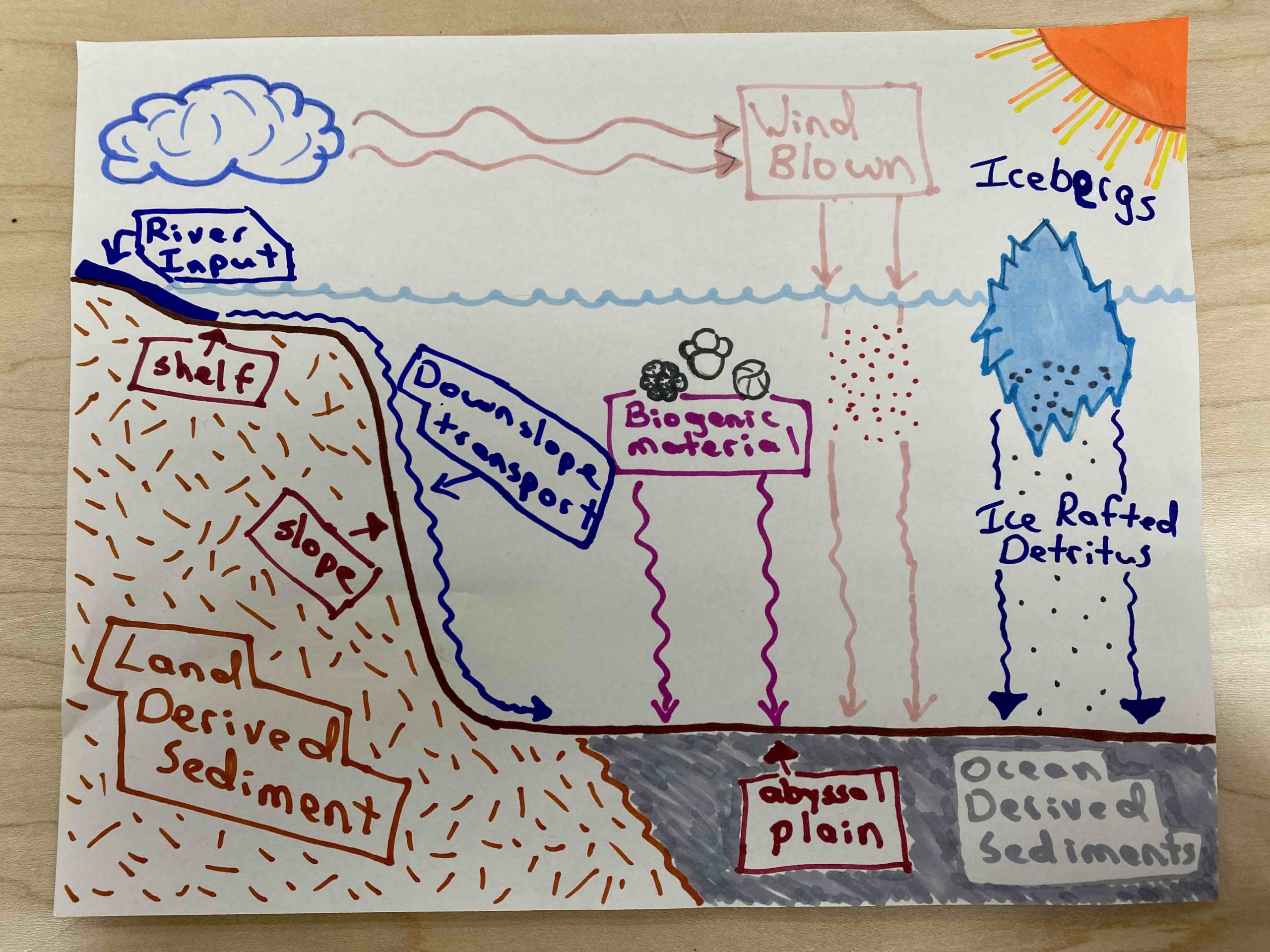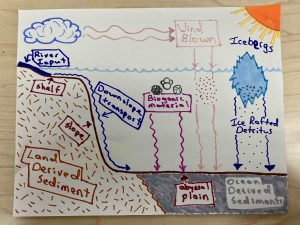
In order to unravel the story in the mud, scientists need to have good understanding of how the mud got there and the processes that deposited the sediment. This way when they see changes in the composition or other physical characteristics, they can use their knowledge of the processes involved to propose an interpretation. The ocean is a very dynamic system and it is hard to speak in absolutes, but I am going to attempt to explain the five majors ways sediment gets to the ocean bottom.
River Input
Look all the way to the left on the above diagram and you will see a blue streak that represents continental rivers. Erosion of terrestrial rocks contributes a massive amount of sediment to rivers. Some of this sediment will be deposited on land, but a large amount will be transported to the edge of continents and deposited on the continental shelf (see my previous post on ocean bathymetry). It is extremely hard to measure the exact amount, but some studies estimate that rivers bring around 13.5 x 109 tons of sediment to the ocean each year. Once the rivers meet the ocean, the water loses most of its energy and drops most of the sediment at the mouth of the river. This is how deltas are formed. All the larger sized particles (i.e. pebble and sand size) will be deposited close to the shore. The smaller particles (i.e. silt and clay size) are able to stay in suspension for a little longer and can settle a little farther away from the mouth of the river. However, this sediment supply is restricted to the continental shelf.
Wind Blown
Global wind patterns also affect the sediment that gets deposited in the deep-ocean. Strong steady winds are able to pick up and suspend silt
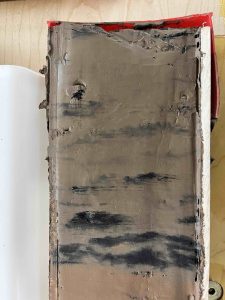
and clay sized particles and transport them 1,000’s of km from their point of origin. Once the wind dies down, the particles will settle through the atmosphere and into the deep-ocean. This is a well-documented phenomenon with Saharan dust, and can be seen from space. Ash from volcanic eruptions can also be transported this way. One of the cores we collected on this cruise had visible ash layers from some ancient volcanic eruption.
Biogenic Material
The ocean is full of primary producers that use photosynthesis or chemosynthesis to build their skeletal material. Microorganisms, such as foraminifera and coccolithophores, produce calcium carbonate shells, whereas diatoms, radiolarians, siliceous sponges, and silicoflagellates produce bodies made of silica. When these microorganisms die, their bodies settle through the water column and get deposited on the deep-sea floor. This process occurs all over the ocean, but is most noticeable in the deep-ocean where there is not as much terrestrial material to dilute the sediment. Sediments rich (>30%) in calcium carbonate are called carbonate or calcareous oozes, and ones high in silica are called siliceous oozes. If you have ever seen a picture of the White Cliffs of Dover, these huge white outcrops were made by carbonate rich sediments being deposited in the deep-ocean over millions of years.
Icebergs
Glaciers, or large bodies of ice in the mountains or covering continents, act as huge bulldozers as they grow and move over land. As they move, all sizes of rock and sediment are picked up and incorporated into the ice. Glaciers are extremely powerful and can move sediment as small as silt and clay, to boulders the size of cars. As glaciers continue to grow, they will eventually reach the edge of continents and large pieces of ice will fall off into the ocean in a process called calving. Once the ice is in the water it will start to float away from its source, slowly melting along the way. As it melts, the sediment trapped in the ice will become dislodged and fall to the ocean floor. This sediment is called Ice Rafted Debris or Detritus, or IRD for short. IRD can be found 1,000’s of km away from their source and scientists use the changes in the amount of this sediment to track the transition from glacial to interglacial periods in the past.
Downslope Transport
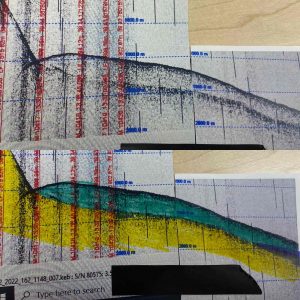
Sometimes sediments do not stay where they were originally deposited. Sediments can be redistributed by bottom water currents or by slope failure events. Large amounts of sediment can be transported along the Continental Slope through turbidites. These are essentially large underwater landslides that deposit large lopes of sediment on the Continental Rise and Abyssal Plain. We have seen many of these deposits on the 3.5 kilohertz seismic profiles that are taken to help determine a coring location. Check out the side by side pictures of the 3.5 where I have outlined the turbidite deposit. I also drew a diagram of this profile with the interpretation of the sediments. Although the
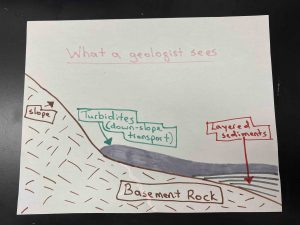
turbidite on the seismic profile might not look very big, it actually represents close 25 m (~82 feet) of sediment. In our case these types of deposits are bad because the slope failure mixes up all the sediments and they no longer contain the nicely layered mud that we need to conduct climate studies. There may be beautiful layers beneath this deposit, but the coring methods we are using on this cruise cannot recover mud that deep.
And that’s it. Well… sorta. Like I said at the top, the ocean is a dynamic system and sediments are constantly being reworked and deposited. It is up to geologists, oceanographers, and scientists to decipher the story hidden in the mud.
